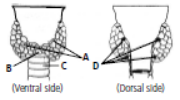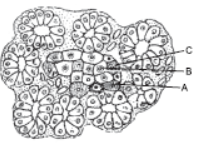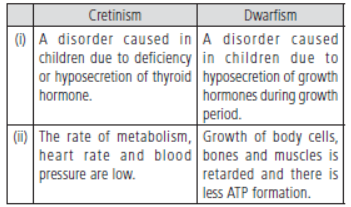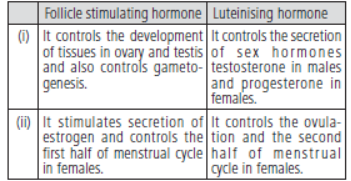Please refer to CBSE Class 11 Biology HOTs Chemical Co-Ordination And Integration. Download HOTS questions and answers for Class 11 Biology. Read CBSE Class 11 Biology HOTs for Chapter 19 Chemical Coordination and Integration below and download in pdf. High Order Thinking Skills questions come in exams for Biology in Class 11 and if prepared properly can help you to score more marks. You can refer to more chapter wise Class 11 Biology HOTS Questions with solutions and also get latest topic wise important study material as per NCERT book for Class 11 Biology and all other subjects for free on Studiestoday designed as per latest CBSE, NCERT and KVS syllabus and pattern for Class 11
Chapter 19 Chemical Coordination and Integration Class 11 Biology HOTS
Class 11 Biology students should refer to the following high order thinking skills questions with answers for Chapter 19 Chemical Coordination and Integration in Class 11. These HOTS questions with answers for Class 11 Biology will come in exams and help you to score good marks
HOTS Questions Chapter 19 Chemical Coordination and Integration Class 11 Biology with Answers
Question. Moon face, buffalo hump, centripetal deposition of fat in belly occurs due to the abnormal functioning of
(a) adrenal medulla
(b) adrenal cortex
(c) anterior pituitary
(d) thyroid gland.
Answer. B
Question. Study the following flow chart that shows calcium regulation by different hormones and identify X, Y and Z.
Anterior lobe of pituitary gland
↓ X
C-cells of thyroid gland
↓ Y
Blood calcium level decreases
↓
Stimulation of chief cells of parathyroid gland
↓ Z
Regulates calcium and phosphate levels in blood
(a) X-Calcitonin, Y-Thyrotropin, Z-Calcitriol
(b) X-Thyrotropin, Y-Calcitriol, Z-Parathormone
(c) X-Thyrotropin, Y-Calcitonin, Z-Parathormone
(d) X-Thyrotropin releasing hormone,
Y-Thyrotropin, Z-Parathormone
Answer. C
Question. Read the given statements and select the correct option.
Statement A : MSH and Melatonin are antagonistic hormones.
Statement B : MSH help in the wide distribution of melanin in melanocytes while melatonin collects the melanin at one place in melanocyte.
(a) Both statements A and B are true and B is the correct explanation of A.
(b) Both statements A and B are true but B is not the correct explanation of A.
(c) Statements A is true but B is false.
(d) Both statements A and B are false.
Answer. A
Question. Read the following statements and choosethe incorrect one.
(a) Corpus luteum only secretes progesterone.
(b) GIP inhibits gastric secretions and contractions.
(c) Cortisol is also considered as stress hormone.
(d) Glucagon stimulates glycogenolysis in liver.
Answer. A
Question. Which of the following statement is incorrect with respect to action of FSH hormone?
(a) It interacts with membrane bound receptors and normally does not enter the target cell.
(b) It generates second messengers like cyclic AMP and Ca++.
(c) It regulates gene expression or chromosome function by the interaction of hormone receptor complex with genome.
(d) It binds with receptors on the ovarian cellme mbrane and regulates physiological responses like ovarian growth.
Answer. C
Question. Observe the given figures and select the option that correctly identifies the labels A, B, C and D.

A B C D
(a) Parathyroid Isthmus Trachea Thyroid gland gland
(b) Thyroid gland Isthmus Trachea Parathyroid gland
(c) Thyroid gland Isthmus Larynx Parathyroid gland
(d) Thyroid gland Corpus Trachea Parathyroid luteum gland
Answer. B
Question. When the primary sexual organ does not develop, puberty may appear due to
(a) stimulation of adrenal cortex
(b) stimulation of adrenal medulla
(c) excessive secretion from gonads
(d) none of these.
Answer. A
Question. Which of the following functions are regulated by melatonin/pineal gland?
A. Defense capability B. Pigmentation
C. Menstrual cycle D. Metabolism
E. Growth and differentiation
F. Body temperature
G. Sleep-wake cycle
(a) A, D, C, F and G
(b) B, C, D, E, F and G
(c) A, C, D and E
(d) A, B, C, D, F and G
Answer. D
Question. FSH of anterior pituitary acts on
(a) interstitial cells of testis
(b) sertoli cells of testis
(c) parafollicular cells of thyroid
(d) sustentacular cells of testis.
Answer. B
Question. During stress, besides epinephrine and norepinephrine which other hormones are also released ?
(a) Thyroxine, cortisol, aldosterone and vasopressin
(b) Cortisol, aldosterone, vasopressin and glucagon
(c) Cortisol, vasopressin, insulin and parathormone
(d) Parathormone, vasopressin, glucagon and thyroxine
Answer. B
Question. Study the given diagram showing the anatomy of pancreas and i d e n t i f y t h e hormones secreted from labelled parts A, B and C.

(a) A-Insulin, B-Somatostatin, C-Glucagon
(b) A-Pancreatic polypeptide, B-Glucagon, C-Insulin
(c) A-Somatostatin, B-Pancreatic polypeptide, C-Glucagon
(d) A-Somatostatin, B-Insulin, C-Glucagon
Answer. D
Question. Recognise the given figure A B and find out the correct matching.
(a) A-Adrenal gland, B-Kidney
(b) A-Kidney, B-Adrenal gland
(c) A-Adrenal medulla, B-Adrenal cortex
(d) A-Adrenal cortex, B-Adrenal medulla
Answer. D
Case Based MCQs
Read the following passage and answer the questions from 41 to 45 given below.
Certain hormones in body are secreted by glands X in response to stress during emergency situations. These hormones increase alertness, pupillary dilation, heart beat and rate of respiration. Hormone secreted by Y is the salt retaining hormone and is responsible for regulation of minerals metabolism.
Question. Catecholamines are derived from which amino acid?
(a) Tryptophan
(b) Phenylalanine
(c) Glutamine
(d) Tyrosine
Answer. D
Question. Name the disease caused by deficiency of hormone secreted by Y.
(a) Addison’s disease
(b) Cushing’s syndrome
(c) Adrenal viruism
(d) Conn’s syndrome
Answer. A
Question. Category of hormone secreted Y is
(a) glucocorticoid
(b) gonadocorticoid
(c) mineralocorticoid
(d) Catecholamine.
Answer. C
Question. Identify the endocrine glands X and Y.
X Y
(a) Adrenal gland Pituitary
(b) Hypothalamus Adrenal gland
(c) Adrenal medulla Adrenal cortex
(d) Adrenal cortex Pineal gland
Answer. C
Question. Which of the following hormones are secreted during emergency situations?
(a) Calcitonin and thymosin
(b) Adrenaline and nor-adrenaline
(c) Aldosterone and adrenaline
(d) Epinephrine only
Answer. B
Very Short Answer Type Questions
Question. Which disease is caused due to hypo functioning of Sertoli cells?
Answer. Male hypogonadism occurs due to the deficiency of androgens-male sex hormones (hypofunction of leydig’s cells), deficiency of sperm formation (hypofunction of Sertoli cells) or both, before puberty. As a result male secondary sexual characters and musculature do not develop.
Question. Name the hormones secreted from the thyroid gland.
Answer. (c) The hormones secreted from the thyroid gland are: Thyroxine (T4), Tri-iodothyronine (T3) and Calcitonin.
Question. Which hormone is secreted in an inactive form?
Answer. Insulin
Question. What are neurohormones?
Answer. Higher animals with well developed nervous system produce special type of hormones, called neurohormones, secreted by some modified nerve cells, and possessing functional characteristics of both nerve and endocrine cells. e.g. oxytocin, ADH, etc.
Question. Name any two heterocrine glands.
Answer. (i) Testes (ii) Pancreas
Short Answer Type Questions
Question. Differentiate between cretinism and dwarfism. Short Answer Type Questions
Answer. Differences between cretinism and dwarfism are :

Question. Explain the endocrine role of placenta.
Answer. Placenta is an intimate connection between the fetus and the uterine wall of the mother to exchange the materials. It is temporarily an endocrine gland. It secretes some hormones like estrogen, progesterone, human chorionic gonadotropin (hCG), human chorionic somatomammotropin – hCS (formerly known as human placental lactogen), chorionic thyrotropin, chorionic corticotropin and relaxin. Estrogen and progesterone have the same roles as in the nonpregnant state. However, the placental progesterone also checks contraction of uterine muscles and thus helps to maintain pregnancy. hCG stimulates progesterone release from the corpus luteum and maintains it. Presence of hCG in urine indicates pregnancy. Human choronic somatomammotropin stimulates the growth of mammary glands. Placental relaxin causes relaxation of the ligaments of pubic symphysis and towards the termination of pregnancy it softens and widens the opening of the cervix for easy child birth.
Question. Give example(s) of
(a) Hyperglycemic hormone and hypoglycemic hormone
(b) Hypercalcemic hormone
(c) Gonadotrophic hormones
(d) Progestational hormone
(e) Blood pressure lowering hormone
(f) Androgens and estrogens.
Answer. (a) Glucagon, insulin (b) Parathormone (PTH) (c) Follicle stimulating hormone (FSH) and luteinizing hormone (LH) (d) Progesterone (e) Atrial natriuretic hormone (f) Testosterone and estradiol
Question. What is exophthalmic goitre? Mention any four symptoms of this disorder. Answer.
Answer. Exophthalmic goitre or Grave’s disease is caused due to hypersecretion of thyroid hormones. It is an autoimmune disease in which a person produces antibodies that mimic the action of TSH but are not regulated by normal negative feedback control. Its symptoms include protrusion of eye balls, loss of weight, rise in body temperature, rapid heart beat, nervousness and restlessness.
Question. How follicle stimulating hormone is different from luteinising hormone?
Answer. Differences between follicle stimulating hormone and luteinising hormone are:

Question. Describe the functions of
(a) FSH,
(b) LH,
(c) LTH.
Answer. (a) FSH – In females it stimulates the development of ovarian follicle. In males it induces the development of seminiferous tubules and production of sperms. (b) LH – In females it regulates the formation of corpus luteum after ovulation and stimulates it to secrete progesterone. But in male it stimulates the interstitial cells of the testes to secrete testosterone hormone. (c) LTH – It promotes breast development to initiate the secretion of milk and also controls the secretion of progesterone by the corpus luteum.
Question. (a) Write the different types of cells of islets of Langerhans and also the hormones produced by them.
(b) How does anti-insulin hormone control glucose level in body?
Answer. (a) Islets of Langerhans of pancreas has four different kinds of cells: (i) a–cells - Produce glucagon (ii) b-cells - Produce insulin (iii) d-cells - Produce somatostatin (iv) Pancreatic polypeptide cells - Produce pancreatic polypeptide. (b) Glucagon is an anti-insulin hormone that stimulates the liver to convert stored glycogen into glucose in the blood. Low level of blood glucose stimulates secretion of glucagon and it signals the liver to release glucose into the blood. High blood glucose level suppresses release of glucagon and stimulates release of insulin.
Long Answer Type Questions
Question. (a) Which hormone is secreted by b-cells of pancreas? Also mention the location of b-cells.
(b) How does this hormone affect various processes in the body?
(c) Describe the disorders resulting from its deficient and excessive production.
Answer. (a) b-cells of pancreas secrete insulin hormone. These cells are usually found towards the middle of the islets of Langerhans. (b) Insulin converts glucose into glycogen in the liver and muscles. Insulin affects various processes in the body, such as : (i) It promotes protein synthesis in tissue from amino acids. (ii) It reduces catabolism of proteins. It is an anabolic hormone. (iii) It increases the synthesis of fat in the adipose tissue from fatty acids. (iv) Insulin reduces the breakdown and oxidation of fat. (c) Disorders of pancreas due to deficient and excessive production of insulin are : (i) Hyperglycemia or Diabetes mellitus : It is due to deficiency of insulin. It is of 2 types – The insulin-dependent diabetes mellitus (IDDM) is caused by a failure of the b-cells to produce adequate amount of insulin while the non-insulin-dependent diabetes mellitus (NIDDM) appears to involve failure of insulin to facilitate the movement of glucose into cells. In both disorders, the blood glucose concentration is elevated above the normal range. Some of the glucose is excreted in the urine and water follows the glucose, causing excessive urination and dehydration of body tissues. This causes excessive thirst (polydipsia). The cells are unable to utilise glucose and other carbohydrates for energy production and due to this reason they utilise their proteins for it. The person becomes very weak. Degradation of fats increases, producing ketone bodies (ketosis) that are acidic and poisonous. Blood cholesterol level rises and healing power is impaired. (ii) Hypoglycemia : It is due to excess of insulin or deficiency of glucagon, or a failure of the secretion of two hormones to completely regulate the blood glucose. The presence of excess insulin is more correctly referred to as hyperinsulinism. Its symptoms include weakness, profuse sweating, irritability, confusion, unconsciousness and convulsions, low blood glucose level, hunger. It needs urgent intake of sugar or glucose.
Chemical Co-Ordination And Integration
Questions. Why is oxytocin called as birth hormone?
Ans1.It induces the vigorous contraction of the smooth muscles of the uterus that lead to the birth of the child.
Questions. What will happen if thyroxin is injected into a tadpole of frog?
Ans2. It will quickly metamorphose into adult frog.
Questions. Why does the effect of noradrenalin last longer?
Ans3. Since noradrenalin I s removed slowly from the blood as compared to adrenalin , it affects last longer.
Questions. Why is thymus called ‘throne of immunity ?
Ans4. Since the T lymphocytes of immune system undergone maturation and proliferation in the thymus and contribute to the immunity of the body it is called throne of immunity.
Questions. Name the two hormone of hypothalamus that influences’ the middle lobe of pituitary. Mention their functions.
Ans5. (1) Melanocytes stimulating –release hormone .Stimulate the function of MSH.
(2) Melanocyte stimulating-inhibiting hormone.It inhibits the release of MSH.
| CBSE Class 11 Biology HOTs The Living World |
| CBSE Class 11 Biology HOTs Biological Classification |
| CBSE Class 11 Biology HOTs Plant Kingdom |
| CBSE Class 11 Biology HOTs Animal Kingdom |
| CBSE Class 11 Biology HOTs Structural Organisation In Animals |
| CBSE Class 11 Biology HOTs Cell And Its Structure |
| CBSE Class 11 Biology HOTs Biomolecule |
| CBSE Class 11 Biology HOTs Cell Cycle And Cell Division |
| CBSE Class 11 Biology HOTs Photosynthesis in Higher Plants |
| CBSE Class 11 Biology HOTs Respiration in Plants |
| CBSE Class 11 Biology HOTs Plant Growth and Development |
| CBSE Class 11 Biology HOTs Breathing and Exchanger of gases |
| CBSE Class 11 Biology HOTs Body Fluids And Circulation |
| CBSE Class 11 Biology HOTs Excretory Products And Their Elimination |
| CBSE Class 11 Biology HOTs Locomotion And Movement |
| CBSE Class 11 Biology HOTs Neural Control and Coordination |
| CBSE Class 11 Biology HOTs Chemical Co-Ordination And Integration |
HOTS for Chapter 19 Chemical Coordination and Integration Biology Class 11
Expert teachers of studiestoday have referred to NCERT book for Class 11 Biology to develop the Biology Class 11 HOTS. If you download HOTS with answers for the above chapter you will get higher and better marks in Class 11 test and exams in the current year as you will be able to have stronger understanding of all concepts. High Order Thinking Skills questions practice of Biology and its study material will help students to have stronger understanding of all concepts and also make them expert on all critical topics. You can easily download and save all HOTS for Class 11 Biology also from www.studiestoday.com without paying anything in Pdf format. After solving the questions given in the HOTS which have been developed as per latest course books also refer to the NCERT solutions for Class 11 Biology designed by our teachers. We have also provided lot of MCQ questions for Class 11 Biology in the HOTS so that you can solve questions relating to all topics given in each chapter. After solving these you should also refer to Class 11 Biology MCQ Test for the same chapter
You can download the CBSE HOTS for Class 11 Biology Chapter 19 Chemical Coordination and Integration for latest session from StudiesToday.com
Yes, the HOTS issued by CBSE for Class 11 Biology Chapter 19 Chemical Coordination and Integration have been made available here for latest academic session
HOTS stands for "Higher Order Thinking Skills" in Chapter 19 Chemical Coordination and Integration Class 11 Biology. It refers to questions that require critical thinking, analysis, and application of knowledge
Regular revision of HOTS given on studiestoday for Class 11 subject Biology Chapter 19 Chemical Coordination and Integration can help you to score better marks in exams
Yes, HOTS questions are important for Chapter 19 Chemical Coordination and Integration Class 11 Biology exams as it helps to assess your ability to think critically, apply concepts, and display understanding of the subject.

